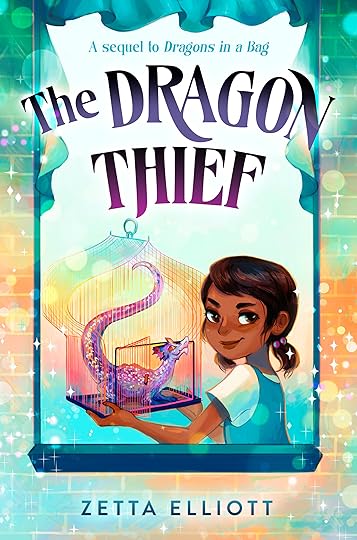Zetta Elliott's Blog, page 22
May 18, 2019
home again?
 I just looked at an international house sitting website! Even though I just got back to Philly after spending nearly 3 weeks on the road, I still feel restless and I’m not sure why. I’ve started watching Escape to the Country again; they just mentioned a monastery and it turns out it accepts guests! Now I’m listening to a discussion of medieval pilgrims…I feel like I’m wandering but without a clear purpose. I know why I was on the road recently: I participated in the Festival of Literary Diversity at the start of May, gave
I just looked at an international house sitting website! Even though I just got back to Philly after spending nearly 3 weeks on the road, I still feel restless and I’m not sure why. I’ve started watching Escape to the Country again; they just mentioned a monastery and it turns out it accepts guests! Now I’m listening to a discussion of medieval pilgrims…I feel like I’m wandering but without a clear purpose. I know why I was on the road recently: I participated in the Festival of Literary Diversity at the start of May, gave 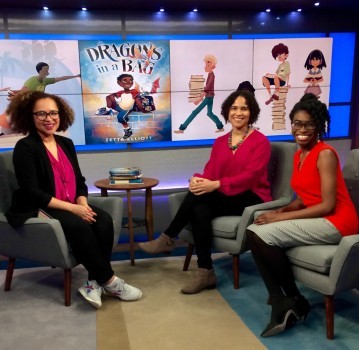 two radio and two television interviews with Canadian media outlets, and then presented at Youngsters 2, the annual conference of the Association for Research in the Cultures of Young People. Got home, had one day to myself, and then I took the train up to NYC for a week-long residency at MS 366 in Canarsie. I wasn’t sure my two classes of sixth-graders were all that interested in Walt Whitman (who turns 200 this month), but their poetry performance on Friday was great. I saw each class for an hour from Monday to Wednesday; on Thursday I went up to MA to present at The Common School. I rarely work with classes that are majority White, and it was interesting to compare the cultures of the private
two radio and two television interviews with Canadian media outlets, and then presented at Youngsters 2, the annual conference of the Association for Research in the Cultures of Young People. Got home, had one day to myself, and then I took the train up to NYC for a week-long residency at MS 366 in Canarsie. I wasn’t sure my two classes of sixth-graders were all that interested in Walt Whitman (who turns 200 this month), but their poetry performance on Friday was great. I saw each class for an hour from Monday to Wednesday; on Thursday I went up to MA to present at The Common School. I rarely work with classes that are majority White, and it was interesting to compare the cultures of the private 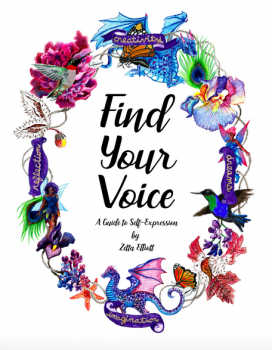 and public school. I was running on fumes by that point but got back to Brooklyn and on Friday morning welcomed my sixth graders to the Dweck auditorium at the central branch of the BPL. They were ready to go—some read Whitman’s poetry and some read their own original poems. One student had memorized her poem and asked me to stand beside her; when her memory failed, she asked for more support and several boys jumped out of their seats to circle her on the stage! I was amazed and stepped back only to have her turn again and say, “Will you stand beside me?” Middle graders can be quite a handful and my patience was certainly tested during the week, but in that moment I remembered that they were still kids…
and public school. I was running on fumes by that point but got back to Brooklyn and on Friday morning welcomed my sixth graders to the Dweck auditorium at the central branch of the BPL. They were ready to go—some read Whitman’s poetry and some read their own original poems. One student had memorized her poem and asked me to stand beside her; when her memory failed, she asked for more support and several boys jumped out of their seats to circle her on the stage! I was amazed and stepped back only to have her turn again and say, “Will you stand beside me?” Middle graders can be quite a handful and my patience was certainly tested during the week, but in that moment I remembered that they were still kids…
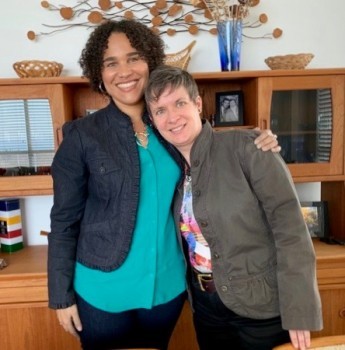 I’ve done a lot of talking over the past three weeks; it was wonderful to see family and friends and to connect with new people, but I’m ready for some silence and solitude. I want to finish my writing workbook this week so I can print copies and try them out on some local students. I have three more NYC gigs and one here in Philly, but then I really do slow down for a while. But what will I do with my wide open weeks? I’ve been writing poems and I finished a board book for the youngest readers, but I need to finish a novel this summer. Will I get back to Sweden and my Viking girls? Or should I keep watching the news and go back to my dystopian tale? I put a lot of effort into beautifying my apartment but now I’m thinking about putting everything in storage when my lease ends in August. I love living in Philly and enjoyed walking
I’ve done a lot of talking over the past three weeks; it was wonderful to see family and friends and to connect with new people, but I’m ready for some silence and solitude. I want to finish my writing workbook this week so I can print copies and try them out on some local students. I have three more NYC gigs and one here in Philly, but then I really do slow down for a while. But what will I do with my wide open weeks? I’ve been writing poems and I finished a board book for the youngest readers, but I need to finish a novel this summer. Will I get back to Sweden and my Viking girls? Or should I keep watching the news and go back to my dystopian tale? I put a lot of effort into beautifying my apartment but now I’m thinking about putting everything in storage when my lease ends in August. I love living in Philly and enjoyed walking 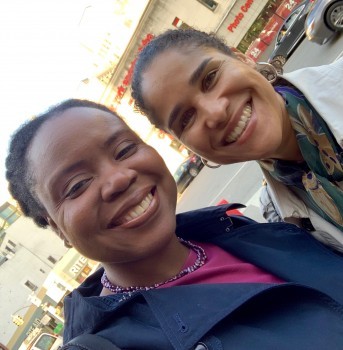 around my pretty neighborhood this sunny Saturday morning. But being in Canada for ten days got me thinking…I couldn’t entirely give up my life in the US, but I could definitely use a break. Each day the news just gets worse and worse, and I do realize that it’s quite a privilege to be able to just up and leave. My sixth graders in Canarsie can’t do that. But I had the chance to work with some sweet first graders in Brampton and would like to connect with more Canadian kids. I haven’t forgotten about the students I met in Edinburgh last spring…and I left Scotland with the same realization: I can do what I do almost anywhere. So where do I belong? Where do I want to be? It was so easy to settle into a life here in Philly—do I need more of a challenge? Should I be looking at places where I don’t speak the language? Or should I try living in the same country as my family? We get along better with a border between us but my mom is getting older…every time I move I leave someone behind. And moves don’t have to be final—sometimes it’s dizzying to have a revolving door life but it might be the only life that’s right for me. Here today, gone tomorrow, but back again another day…
around my pretty neighborhood this sunny Saturday morning. But being in Canada for ten days got me thinking…I couldn’t entirely give up my life in the US, but I could definitely use a break. Each day the news just gets worse and worse, and I do realize that it’s quite a privilege to be able to just up and leave. My sixth graders in Canarsie can’t do that. But I had the chance to work with some sweet first graders in Brampton and would like to connect with more Canadian kids. I haven’t forgotten about the students I met in Edinburgh last spring…and I left Scotland with the same realization: I can do what I do almost anywhere. So where do I belong? Where do I want to be? It was so easy to settle into a life here in Philly—do I need more of a challenge? Should I be looking at places where I don’t speak the language? Or should I try living in the same country as my family? We get along better with a border between us but my mom is getting older…every time I move I leave someone behind. And moves don’t have to be final—sometimes it’s dizzying to have a revolving door life but it might be the only life that’s right for me. Here today, gone tomorrow, but back again another day…
April 17, 2019
spark or seed?
 A book is not a machine but it IS an invention—as a writer I’m part dreamer and part engineer. Yesterday I spoke with Stephanie Toliver, a doctoral candidate at UGA whose research is on Black girls’ reader responses to speculative fiction with Black female protagonists. Hearing about the girls’ reactions to CIN’S MARK absolutely made my day—and I felt vindicated, as any inventor would, that my creation was working as intended! It’s like putting levers into certain passages and you hope the reader will stop to pull the lever, agree with or challenge a point you’ve raised, and that’s what was happening within the book club. The girls started with BINTI by Nnedi Okorafor and that’s a tough act to follow, but I’m glad they’re relating to my teen protagonists. Whether I’m writing time travel or a ghost story, I try to first establish a relationship to the contemporary moment by creating characters who live in a world teen readers can recognize. It’s hard when you invent something you think will help others and then your invention gathers dust on the shelf, so I’m very grateful that such a skilled educator chose to use my book.
A book is not a machine but it IS an invention—as a writer I’m part dreamer and part engineer. Yesterday I spoke with Stephanie Toliver, a doctoral candidate at UGA whose research is on Black girls’ reader responses to speculative fiction with Black female protagonists. Hearing about the girls’ reactions to CIN’S MARK absolutely made my day—and I felt vindicated, as any inventor would, that my creation was working as intended! It’s like putting levers into certain passages and you hope the reader will stop to pull the lever, agree with or challenge a point you’ve raised, and that’s what was happening within the book club. The girls started with BINTI by Nnedi Okorafor and that’s a tough act to follow, but I’m glad they’re relating to my teen protagonists. Whether I’m writing time travel or a ghost story, I try to first establish a relationship to the contemporary moment by creating characters who live in a world teen readers can recognize. It’s hard when you invent something you think will help others and then your invention gathers dust on the shelf, so I’m very grateful that such a skilled educator chose to use my book.
 I’ve submitted a workshop proposal for the upcoming SWaG Instructional Equity conference in NYC: “I Dream a World”: Black Feminist Visions of the Future in Young Adult Literature. Many educators don’t seem to take speculative fiction seriously—especially when it comes to Black students. Instead they get the diet of “liver and Brussels sprouts books” full of noble characters who overcome oppression under slavery or during the Civil Rights era. But spec fic can teach readers just as much about social justice—and many YA novels can be linked to topics covered in social studies and science class. Plus students are excited by spec fic and once you have that spark, so much more can happen than when you assign a “classic” that kids find dull or irrelevant. I often say I’m sowing seeds but I also want my writing to be the spark that lights a fire inside kids who never thought reading was important or fun. I’m heading to Harlem tomorrow and then I’ll visit Girard College here in Philly next week. Hopefully I’ll get to see the students I met last month, one of whom wrote the above article for the school paper. I’m struggling with the poem-a-day challenge so I’m hoping that getting kids to read and write will light a fire inside of me, too!
I’ve submitted a workshop proposal for the upcoming SWaG Instructional Equity conference in NYC: “I Dream a World”: Black Feminist Visions of the Future in Young Adult Literature. Many educators don’t seem to take speculative fiction seriously—especially when it comes to Black students. Instead they get the diet of “liver and Brussels sprouts books” full of noble characters who overcome oppression under slavery or during the Civil Rights era. But spec fic can teach readers just as much about social justice—and many YA novels can be linked to topics covered in social studies and science class. Plus students are excited by spec fic and once you have that spark, so much more can happen than when you assign a “classic” that kids find dull or irrelevant. I often say I’m sowing seeds but I also want my writing to be the spark that lights a fire inside kids who never thought reading was important or fun. I’m heading to Harlem tomorrow and then I’ll visit Girard College here in Philly next week. Hopefully I’ll get to see the students I met last month, one of whom wrote the above article for the school paper. I’m struggling with the poem-a-day challenge so I’m hoping that getting kids to read and write will light a fire inside of me, too!
March 29, 2019
riding the rails
 I’ve been on the road for the past week—on the rails, really, since I took the train from Philly to Providence and then back up to Boston. It feels good to be home but it always takes a while for me to settle back into my usual routine. Just got some groceries and went for a run yesterday morning; much as I love seeing cherry trees and even magnolias in bloom, it’s hard on my allergies and those awful sinus headaches have returned. But I am READY for spring and I’ve got more trips ahead, so I figured I’d better blog about my travel otherwise it’ll become a blur. Last weekend I went to Rhode Island for the first time and presented on a panel at KidLitCon–“Diverse Fantasy in the Real World.” My copanelists Rajani LaRocca and with them and talk about the distance we’ve traveled in our lives since meeting more than a decade ago. Jane and I met when we were visiting profs at Mt. Holyoke College and we’ve both since pursued
I’ve been on the road for the past week—on the rails, really, since I took the train from Philly to Providence and then back up to Boston. It feels good to be home but it always takes a while for me to settle back into my usual routine. Just got some groceries and went for a run yesterday morning; much as I love seeing cherry trees and even magnolias in bloom, it’s hard on my allergies and those awful sinus headaches have returned. But I am READY for spring and I’ve got more trips ahead, so I figured I’d better blog about my travel otherwise it’ll become a blur. Last weekend I went to Rhode Island for the first time and presented on a panel at KidLitCon–“Diverse Fantasy in the Real World.” My copanelists Rajani LaRocca and with them and talk about the distance we’ve traveled in our lives since meeting more than a decade ago. Jane and I met when we were visiting profs at Mt. Holyoke College and we’ve both since pursued 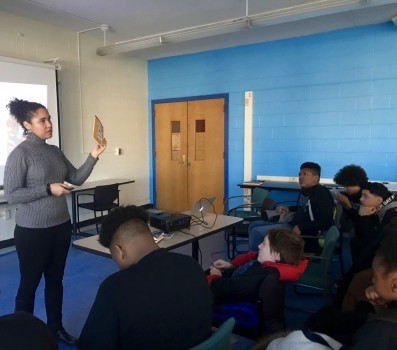 the “alt-ac” life. Jane told me about Sophia Academy and I was able to visit the impressive young scholars there; I gave a book talk and then led two writing workshops where I was blown away by the scholars’ creativity and thoughtfulness as we talked about identity and who gets to define us… I got to hang out with some kid lit scholar friends in Providence, too, and look forward to seeing them again in Madison, WI when we gather next month to hear Debbie Reese deliver the Arbuthnot Honor Lecture. After Providence I had a day to relax before getting back on the train to head up to Boston. This was my
the “alt-ac” life. Jane told me about Sophia Academy and I was able to visit the impressive young scholars there; I gave a book talk and then led two writing workshops where I was blown away by the scholars’ creativity and thoughtfulness as we talked about identity and who gets to define us… I got to hang out with some kid lit scholar friends in Providence, too, and look forward to seeing them again in Madison, WI when we gather next month to hear Debbie Reese deliver the Arbuthnot Honor Lecture. After Providence I had a day to relax before getting back on the train to head up to Boston. This was my  second invitation from Wondermore and this year we ventured outside of the city; on Tuesday I presented for over two hundred first graders in Bedford and the next day I gave four more book talks at McCormack MS and Sumner Elementary School. I won’t lie—giving 8 book talks in 2 days is exhausting! But when I’m in the classroom and the room is quiet except for the sound of my voice…or when I see eyes opening wide…or when hands shoot up in the air during the Q&A…then I feel so energized by the young readers, especially when they rush up at the end and want to get their hands on my books or give me a hug. Wondermore generously donates books to schools in low-income communities, and I left a couple of copies of Say Her Name at the middle school. Their library is entirely funded by teachers and staffed by volunteers…
second invitation from Wondermore and this year we ventured outside of the city; on Tuesday I presented for over two hundred first graders in Bedford and the next day I gave four more book talks at McCormack MS and Sumner Elementary School. I won’t lie—giving 8 book talks in 2 days is exhausting! But when I’m in the classroom and the room is quiet except for the sound of my voice…or when I see eyes opening wide…or when hands shoot up in the air during the Q&A…then I feel so energized by the young readers, especially when they rush up at the end and want to get their hands on my books or give me a hug. Wondermore generously donates books to schools in low-income communities, and I left a couple of copies of Say Her Name at the middle school. Their library is entirely funded by teachers and staffed by volunteers…
Next weekend I head back to NYC for Kweli and then it’s Wisconsin, Connecticut, NYC again, before I fly up to Canada for the Festival of Literary Diversity! I’m supposed to get back to Sweden, too, but will have to play that by ear. For now I’m just glad to be home for a whole week!
February 15, 2019
book bling
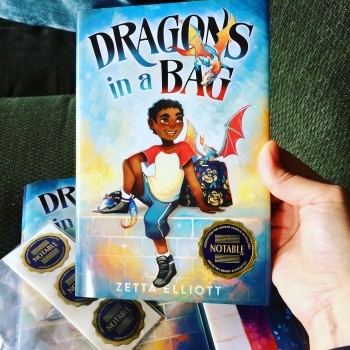 My stickers arrived today! There’s nothing like having a little bling on your book. I feel like this has been a productive week even though I haven’t written much. I’ve read a lot and today I started my taxes (ugh). I’m heading to KidLitCon in Providence, RI next month and just lined up an author visit at a girls academy there. I also booked a trip to Madison, WI to attend the annual Arbuthnot Honor Lecture, which will be delivered by the brilliant Debbie Reese. I’m still thinking about Sweden and will need to head back to observe the arrival of spring and visit the Viking museum at Birka. I’m trying to have 5K words written by the end of this month and that still seems possible. I can hear my girl’s voice and the two ravens, Huginn and Muninn; Hami is coming to me slowly and I may just have to write his words and work on tone later. Tomorrow I’ll spend the afternoon at the library—my first visit to the central branch of Philly’s Free Library. I’ll be presenting at a local branch in Chestnut Hill later this month and at two other branches in March. Slowly but surely I’m connecting with kids in Philly! Sometimes you push and sometimes you wait…in time, it all comes together.
My stickers arrived today! There’s nothing like having a little bling on your book. I feel like this has been a productive week even though I haven’t written much. I’ve read a lot and today I started my taxes (ugh). I’m heading to KidLitCon in Providence, RI next month and just lined up an author visit at a girls academy there. I also booked a trip to Madison, WI to attend the annual Arbuthnot Honor Lecture, which will be delivered by the brilliant Debbie Reese. I’m still thinking about Sweden and will need to head back to observe the arrival of spring and visit the Viking museum at Birka. I’m trying to have 5K words written by the end of this month and that still seems possible. I can hear my girl’s voice and the two ravens, Huginn and Muninn; Hami is coming to me slowly and I may just have to write his words and work on tone later. Tomorrow I’ll spend the afternoon at the library—my first visit to the central branch of Philly’s Free Library. I’ll be presenting at a local branch in Chestnut Hill later this month and at two other branches in March. Slowly but surely I’m connecting with kids in Philly! Sometimes you push and sometimes you wait…in time, it all comes together.
February 12, 2019
on campus
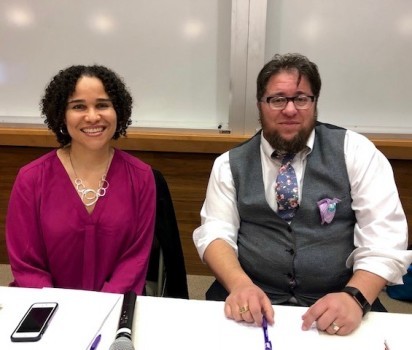 I’m happy to be off the road for a while after two back-to-back campus visits this month. It’s tiring but so worthwhile—I definitely miss teaching and so it’s great to be back in the classroom or having one-on-one discussions with college students. Last week I was invited to Denison University as a speaker in their Laura C. Harris series; Bear S. Bergman and I answered the question, “What’s so subversive about inclusive kid lit?” and talked about using indie publishing and micro-presses to produce radical kid lit. Flamingo Rampant is publishing so many amazing stories for kids—be sure to check out their selection of books representing all types of families. I don’t think I’ll ever became a publisher; it’s hard enough just trying to get my
I’m happy to be off the road for a while after two back-to-back campus visits this month. It’s tiring but so worthwhile—I definitely miss teaching and so it’s great to be back in the classroom or having one-on-one discussions with college students. Last week I was invited to Denison University as a speaker in their Laura C. Harris series; Bear S. Bergman and I answered the question, “What’s so subversive about inclusive kid lit?” and talked about using indie publishing and micro-presses to produce radical kid lit. Flamingo Rampant is publishing so many amazing stories for kids—be sure to check out their selection of books representing all types of families. I don’t think I’ll ever became a publisher; it’s hard enough just trying to get my 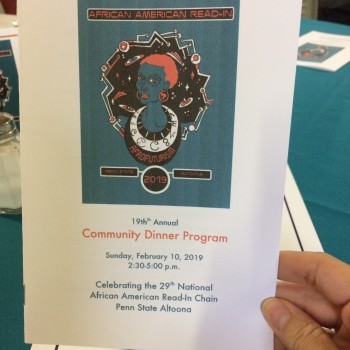 own work into the world! I got home on Friday and then early Sunday morning hit the road again. During the five-hour trip to Penn State, Altoona I did some quality dreaming and then used the subsequent snowy day to work on a few chapters of my Viking novel. I arrived just in time for the community dinner and joined their Afrofuturism-themed African American Read-In by sharing a bit of Dragons in a Bag. The next evening I gave a talk on my fantasy fiction for teens and wrapped up with a reading of Cin’s Mark. The weather turned treacherous last night and campus was closed today, but an intrepid prof drove me to the train station this morning and Amtrak got me back home to Philly. I have a few more events this month but they’re LOCAL. I do love visiting new places but I’m looking forward to staying put for a while…
own work into the world! I got home on Friday and then early Sunday morning hit the road again. During the five-hour trip to Penn State, Altoona I did some quality dreaming and then used the subsequent snowy day to work on a few chapters of my Viking novel. I arrived just in time for the community dinner and joined their Afrofuturism-themed African American Read-In by sharing a bit of Dragons in a Bag. The next evening I gave a talk on my fantasy fiction for teens and wrapped up with a reading of Cin’s Mark. The weather turned treacherous last night and campus was closed today, but an intrepid prof drove me to the train station this morning and Amtrak got me back home to Philly. I have a few more events this month but they’re LOCAL. I do love visiting new places but I’m looking forward to staying put for a while…
February 1, 2019
melt with us!
 I was thrilled to be a guest on Lori Tharps’ podcast My American Meltingpot—and the episode we taped last week is live today! Want to hear more about my Viking novel-in-progress? Then tune in! It’s a great way to start Black History Month and Lori provides lots of links on her website in case you want to learn more about the topics we discussed.
I was thrilled to be a guest on Lori Tharps’ podcast My American Meltingpot—and the episode we taped last week is live today! Want to hear more about my Viking novel-in-progress? Then tune in! It’s a great way to start Black History Month and Lori provides lots of links on her website in case you want to learn more about the topics we discussed.
I also learned today that DRAGONS IN A BAG has been named a 2018 Notable Children’s Book by the Association for Library Service to Children (ALSC). BIRD also received that honor…ten years ago! I’m working with four editors these days because I have four books in various stages of production. As soon as we get one manuscript edited, another one needs my attention. Not complaining, though! Came down with a cold while I was in London so wasn’t as productive as I’d hoped but once these edits are out of the way, I’ll be writing again…
January 23, 2019
Have you seen her?
It’s wonderful to get daily messages from teachers telling me how much their students LOVE Dragons in a Bag! And now ARCs of the sequel are here…The Dragon Thief won’t be published until October but you can learn more about Book 2 by reading my interview with Edith Campbell over at CrazyQuiltEdi.
January 12, 2019
my girl
 I haven’t come up with a name for my character yet so I call her “my girl.” Christina Myrvold is working on a stunning visual representation, which I plan to hang on the wall next to my desk. She’s a sad one, my girl, believing her mother got rid of her by giving her to a Swedish trader when really she was just trying to save her daughter from a worse fate. I’m not a romantic—I couldn’t stand Outlander—so I’m not going to pretend that my girl eventually comes to love her much older White husband. She’s twelve when he starts raping her and she takes her own life four years (and two babies) later. It’s grim, especially with R. Kelly in my newsfeed right now, and so I’m writing my girl’s words in verse. I want to reflect her inability to speak fully and/or fluently in a language she doesn’t understand. And I want to show the trauma of being young and alone and afraid with no real way of going home. I love to travel (well, I love being in new places) and I know it’s a privilege to book a ticket and simply fly away. I was unhappy in Toronto and because my father was in Brooklyn, I was able to move. Now I’m trying to arrange my life so that I can leave the US when I need to. Yesterday I booked a trip to London; I just got back from
I haven’t come up with a name for my character yet so I call her “my girl.” Christina Myrvold is working on a stunning visual representation, which I plan to hang on the wall next to my desk. She’s a sad one, my girl, believing her mother got rid of her by giving her to a Swedish trader when really she was just trying to save her daughter from a worse fate. I’m not a romantic—I couldn’t stand Outlander—so I’m not going to pretend that my girl eventually comes to love her much older White husband. She’s twelve when he starts raping her and she takes her own life four years (and two babies) later. It’s grim, especially with R. Kelly in my newsfeed right now, and so I’m writing my girl’s words in verse. I want to reflect her inability to speak fully and/or fluently in a language she doesn’t understand. And I want to show the trauma of being young and alone and afraid with no real way of going home. I love to travel (well, I love being in new places) and I know it’s a privilege to book a ticket and simply fly away. I was unhappy in Toronto and because my father was in Brooklyn, I was able to move. Now I’m trying to arrange my life so that I can leave the US when I need to. Yesterday I booked a trip to London; I just got back from  Sweden but that wasn’t an enjoyable trip, really. Necessary, and productive, but not fun. In London I’ve got friends waiting for me, and Rosa (who’s spending the month there) has already made a reservation for tea at Kensington Palace. My hotel room looks tiny but I don’t need much space, just a quiet corner where I can set up my laptop and write. I’m aiming to have three solid chapters and a complete summary/table of contents to share with my agent by the end of this month. I don’t see The Ring as a young adult novel but all the main characters are children or teenagers so that might be my best bet. It scares me a little, this story. It’s been unfolding in my head for years but now that I need to write it down…I wonder what I’m trying to say. We don’t need another mirror that merely shows Black girls being exploited and abused in the past. There has to be a path to healing hidden somewhere in my imagination. My girl has two daughters and there’s hope there, though they make very different choices in the way they live their lives. And there’s a boy who doesn’t quite grow to manhood but whose kindness sustains the three girls in various ways. I made a To Do list today—plenty of reading, organizing, and research to be done before London…
Sweden but that wasn’t an enjoyable trip, really. Necessary, and productive, but not fun. In London I’ve got friends waiting for me, and Rosa (who’s spending the month there) has already made a reservation for tea at Kensington Palace. My hotel room looks tiny but I don’t need much space, just a quiet corner where I can set up my laptop and write. I’m aiming to have three solid chapters and a complete summary/table of contents to share with my agent by the end of this month. I don’t see The Ring as a young adult novel but all the main characters are children or teenagers so that might be my best bet. It scares me a little, this story. It’s been unfolding in my head for years but now that I need to write it down…I wonder what I’m trying to say. We don’t need another mirror that merely shows Black girls being exploited and abused in the past. There has to be a path to healing hidden somewhere in my imagination. My girl has two daughters and there’s hope there, though they make very different choices in the way they live their lives. And there’s a boy who doesn’t quite grow to manhood but whose kindness sustains the three girls in various ways. I made a To Do list today—plenty of reading, organizing, and research to be done before London…
January 5, 2019
silver
 I got my first silver bangle when I was fifteen. My father and his second wife took us to Jamaica and I came back to Canada with a thin engraved band around my wrist. I went to Nevis when I was thirty; I gave my aunt some money to help with her expenses and instead she used it to buy me a thick silver bangle. Over the years I acquired more and more until I couldn’t write on the board without treating my students to a jangling symphony. My favorite bracelet wasn’t a bangle at all—it was a series of linked silver cowrie shells. I don’t remember now why I stopped wearing my bracelets. I hardly wear any jewelry these days but when I went to the Swedish History Museum today and saw the hoards on display, it reminded me of my magpie tendencies—I like shiny things and I collect them but rarely put them on display. The Vikings exhibit in Philly didn’t include any cowrie shells but the one I saw in Colorado a couple of years ago did. For three years I’ve been gathering these connections,
I got my first silver bangle when I was fifteen. My father and his second wife took us to Jamaica and I came back to Canada with a thin engraved band around my wrist. I went to Nevis when I was thirty; I gave my aunt some money to help with her expenses and instead she used it to buy me a thick silver bangle. Over the years I acquired more and more until I couldn’t write on the board without treating my students to a jangling symphony. My favorite bracelet wasn’t a bangle at all—it was a series of linked silver cowrie shells. I don’t remember now why I stopped wearing my bracelets. I hardly wear any jewelry these days but when I went to the Swedish History Museum today and saw the hoards on display, it reminded me of my magpie tendencies—I like shiny things and I collect them but rarely put them on display. The Vikings exhibit in Philly didn’t include any cowrie shells but the one I saw in Colorado a couple of years ago did. For three years I’ve been gathering these connections, 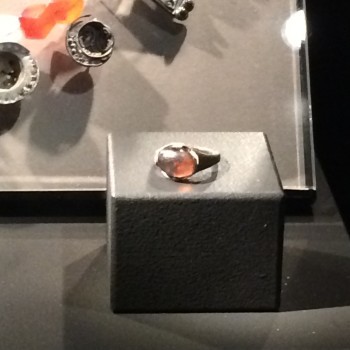 trying to make the Viking world feel familiar in some way. Yet here in Sweden I feel very foreign. I don’t speak the language, I haven’t seen many Black women, though a sister from Cyprus stopped me on the street to ask for money. I thought she wanted directions at first but with a map in my hand, I clearly wasn’t equipped to do that. But I guess I looked privileged—and I am. My social anxiety makes travel pretty challenging sometimes, but yesterday I had everything planned: got up and went for a run; did some laundry and then packed; I got to the train station in Philly, took Amtrak to Penn Station, got the A train to JFK, got my bag checked with the help of a kind desk agent, and then seven hours later I was in Stockholm! I’d bought my bus ticket in advance and when I got off at Central Terminal, I just asked the teen at the information desk to point me in the right direction. I’d already printed out a city map and had my hotel route traced. Got checked in, got cleaned up, and went over to the museum, which is just a ten-minute walk away. Everything felt easy and yet I felt a little blue at times today…not sure why. I think the language difference is real; you just feel shut out even when people aren’t
trying to make the Viking world feel familiar in some way. Yet here in Sweden I feel very foreign. I don’t speak the language, I haven’t seen many Black women, though a sister from Cyprus stopped me on the street to ask for money. I thought she wanted directions at first but with a map in my hand, I clearly wasn’t equipped to do that. But I guess I looked privileged—and I am. My social anxiety makes travel pretty challenging sometimes, but yesterday I had everything planned: got up and went for a run; did some laundry and then packed; I got to the train station in Philly, took Amtrak to Penn Station, got the A train to JFK, got my bag checked with the help of a kind desk agent, and then seven hours later I was in Stockholm! I’d bought my bus ticket in advance and when I got off at Central Terminal, I just asked the teen at the information desk to point me in the right direction. I’d already printed out a city map and had my hotel route traced. Got checked in, got cleaned up, and went over to the museum, which is just a ten-minute walk away. Everything felt easy and yet I felt a little blue at times today…not sure why. I think the language difference is real; you just feel shut out even when people aren’t 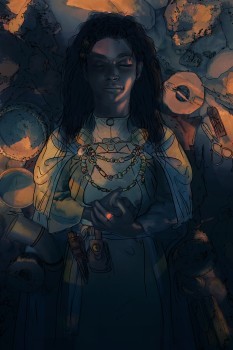 talking to you. Almost everyone speaks English as well but I don’t know Swedish culture and history the way I know the Brits. In the UK I can take a lot for granted, plus I have friends there. I’m on my own here in Stockholm but I’ve got plans—back to the museum tomorrow before the Vikings exhibit closes, then a walking tour of the Old City, and then I’ll hopefully start to write. There’s limited daylight here—sun’s up at 8:30am and gone by 4pm. I missed the Northern Lights and the museum at Birka is closed for the winter, so I’ll have to come back. On the ride from the airport I kept noticing how many birch trees were growing in the fields. I feel like I’m HER, in a way—this frightened girl I’ve dreamed up who left her mother, her home, her entire world in Iraq/Iran to start again in Birka. If she arrived in wintertime, the snow and cold would have been a shock…and then birch trees. I’ve always loved them but for a girl accustomed to palm trees and brown-skinned people and a warm climate, what a shock—“Even the skin of the trees is white…” I’ve reached out to a migrant settlement group to see if I could donate some books. And I might attend their free language class on Tuesday! Couldn’t keep my eyes open a while ago and now I’m wide awake. Will read my new book and see if that puts me to sleep…Christina Myrvold is hard at work on a cover for The Ring. All my girl needs now is a name…
talking to you. Almost everyone speaks English as well but I don’t know Swedish culture and history the way I know the Brits. In the UK I can take a lot for granted, plus I have friends there. I’m on my own here in Stockholm but I’ve got plans—back to the museum tomorrow before the Vikings exhibit closes, then a walking tour of the Old City, and then I’ll hopefully start to write. There’s limited daylight here—sun’s up at 8:30am and gone by 4pm. I missed the Northern Lights and the museum at Birka is closed for the winter, so I’ll have to come back. On the ride from the airport I kept noticing how many birch trees were growing in the fields. I feel like I’m HER, in a way—this frightened girl I’ve dreamed up who left her mother, her home, her entire world in Iraq/Iran to start again in Birka. If she arrived in wintertime, the snow and cold would have been a shock…and then birch trees. I’ve always loved them but for a girl accustomed to palm trees and brown-skinned people and a warm climate, what a shock—“Even the skin of the trees is white…” I’ve reached out to a migrant settlement group to see if I could donate some books. And I might attend their free language class on Tuesday! Couldn’t keep my eyes open a while ago and now I’m wide awake. Will read my new book and see if that puts me to sleep…Christina Myrvold is hard at work on a cover for The Ring. All my girl needs now is a name…
January 4, 2019
hometown love
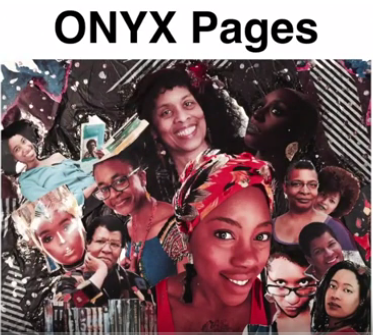 I don’t generally think of Toronto as my hometown, but I did grow up in the GTA (Greater Toronto Area) and lately they’ve been showing me a little love. Today I have an article in The Toronto Star and last week Booktuber Njeri Damali Sojourner-Campbell posted this wonderful review of CIN’S MARK on her channel Onyx Pages. She has a keen critical eye so it means a lot that my novel resonated with her.
I don’t generally think of Toronto as my hometown, but I did grow up in the GTA (Greater Toronto Area) and lately they’ve been showing me a little love. Today I have an article in The Toronto Star and last week Booktuber Njeri Damali Sojourner-Campbell posted this wonderful review of CIN’S MARK on her channel Onyx Pages. She has a keen critical eye so it means a lot that my novel resonated with her.
A few days ago I turned in my revised poetry manuscript (yay!). I’m heading to Sweden in a few hours and love the anonymity that comes with travel. But being invisible in Canada isn’t something I enjoy, so it feels good to finally have my voice heard. Here’s a bit of what I wrote for The Star:
It’s not easy being a Black child in the Great White North. I grew up on the outskirts of Toronto; in the 1970s and ’80s I had no Black teachers and no one working at the library looked like me. Black children were largely absent from the books I read as well. I adored fantasy fiction but fairies, unicorns, and magic carpets belonged to White children in England — not awkward Black girls in Canada.
So when I wrote my first picture book as a teen, my adventurous little girl was White and her family looked nothing like mine. Like Mary Poppins with her remarkable umbrella, Violet grabbed hold of a kite and sailed away for the day. I had been invisible for so long that I automatically erased myself without ever considering that I had a right to create and inhabit magical worlds.
If I’d had something like Onyx Pages when I was a teen, I might have felt less alone as a fantasy reader and emerging writer. I have no regrets about leaving Canada for the US but most Black kids can’t follow in my footsteps; things have got to change in the Great White North…maybe my article can start that conversation.
See you in Stockholm!


